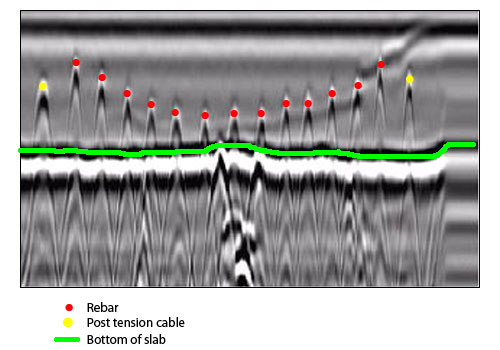Precision and Precision in Concrete Scanning Solutions
Wiki Article
Past the Surface Area: Leveraging Advanced Concrete Scanning Techniques for Unmatched Accuracy and Insight
In the realm of building and facilities maintenance, the pursuit for precision and thoroughness is endless. Advanced concrete scanning techniques have become important devices in this quest, using a peek underneath the surface to unveil a world of essential understandings. By utilizing innovative innovations, experts can discover abnormalities, assess the problem of concrete structures, and make educated choices that shape the program of projects. The ramifications of these methods extend much beyond plain surface-level evaluations, guaranteeing a deepness of precision and understanding that is unrivaled.Significance of Advanced Concrete Scanning
The significance of using advanced concrete scanning methods depends on the exceptional precision they offer for spotting sub-surface anomalies and making sure structural integrity. By using innovative innovations such as ground-penetrating radar (GPR), electro-magnetic induction, and progressed sonar imaging, construction experts can dig underneath the surface area of concrete frameworks with a degree of precision that far goes beyond traditional evaluation approaches. Concrete Scanning. These strategies enable the identification of covert hazards like rebar rust, gaps, conduits, or post-tension cables that could compromise the security and security of a structure over timeIn addition, advanced concrete scanning provides invaluable insights into the general problem of a concrete component without the demand for invasive steps, decreasing the threat of creating damages throughout the analysis process. The capacity to pinpoint the exact location and deepness of possible concerns enables targeted repair services and maintenance, inevitably prolonging the life-span of the framework and optimizing its efficiency. In significance, the value of innovative concrete scanning can not be overemphasized in the world of building and infrastructure upkeep, where accuracy and integrity are vital.
Kinds Of Cutting-Edge Technologies

Anomalies and Flaw Discovery

Along with GPR, concrete scanning strategies like thermography and impact-echo screening are additionally reliable in identifying anomalies and defects. Thermography makes use of infrared modern technology to identify variations in surface area temperature level, indicating potential locations of concern such as delamination or dampness ingress. On the various other hand, impact-echo screening involves examining acoustic feedbacks to discover gaps, cracks, and various other defects within the concrete. By leveraging these innovative techniques, professionals can proactively attend to structural issues, guaranteeing the longevity and security of concrete structures.
Assessing Concrete Problem
Just how can designers precisely evaluate the condition of concrete structures to ensure their long life and safety and security? Examining the concrete condition is an essential element of keeping framework honesty. Numerous sophisticated concrete scanning techniques are utilized for this purpose. Ground-penetrating radar (GPR) is generally made use of to examine the internal structure of concrete, detecting spaces, fractures, and various other abnormalities that may endanger its toughness. Additionally, impact-echo screening can give understandings into the thickness and integrity of concrete elements. Ultrasonic pulse velocity testing is an additional valuable approach for examining concrete quality by determining the rate of acoustic waves with the material.Incorporating non-destructive screening methods with visual inspections permits for a detailed analysis of concrete condition, making it possible for engineers to recognize possible problems early on and implement prompt upkeep or repair services. By leveraging these innovative strategies, engineers can ensure the long-term toughness and safety of concrete frameworks.
Enhancing Decision-Making Procedures
In the world of facilities monitoring, maximizing decision-making processes is essential for making certain the reliable maintenance and durability of concrete Home Page structures. Enhanced decision-making procedures in concrete management include utilizing innovative scanning methods to gather detailed information on the condition of frameworks. By leveraging innovations such as ground-penetrating radar and 3D imaging, stakeholders can make educated decisions relating to support, replacement, or fixing methods.These progressed scanning techniques offer very useful insights right into the internal structure of concrete, recognizing potential issues such as gaps, splits, or rust that might not be noticeable on the surface area. This degree of comprehensive info permits aggressive upkeep planning, lessening the danger of structural failures and raising the total lifespan of concrete frameworks.
Moreover, by integrating electronic paperwork and evaluation devices into the decision-making procedure, stakeholders can track the advancement of concrete conditions in time, allowing anticipating upkeep techniques and maximizing resource appropriation. Ultimately, the combination of advanced concrete scanning strategies enhances decision-making processes by supplying unequaled precision, understanding, and performance in facilities administration.
Final Thought
In verdict, advanced concrete scanning strategies offer unmatched accuracy and insight in discovering anomalies, defects, and assessing the condition of concrete frameworks. By leveraging advanced technologies, decision-making procedures can be boosted, causing even more efficient and informed solutions for preserving wikipedia reference and fixing concrete framework. These strategies play a vital duty in making sure the security and durability of concrete frameworks, making them an indispensable tool in the field of building and design.Furthermore, progressed concrete scanning offers important insights right into the overall problem of a concrete component without the requirement for invasive actions, lessening the risk of triggering damage throughout the analysis procedure - Concrete Scanning. An additional cutting-edge modern technology is 3D X-ray scanning, which gives thorough images of the inner framework of concrete, offering important details without the requirement for damaging screening. Additionally, Concrete Cover Meters are used to gauge the density of concrete cover over support bars precisely. Improved decision-making processes in concrete monitoring entail making use of visit this website advanced scanning techniques to gather comprehensive information on the problem of frameworks.In final thought, advanced concrete scanning strategies supply unmatched accuracy and insight in finding abnormalities, flaws, and assessing the condition of concrete frameworks
Report this wiki page